Editor's note: With the launch of the Xbox Series X and S, Gears 5 has been optimized to take advantage of the next-gen hardware. Below are our impressions of how the game runs on Series X, written by Eddie Makuch. You can also read our full Xbox Series X review for an in-depth breakdown of the console. Continue after the break for the original Gears 5 review.
Microsoft's Gears 5 is one of the 30-plus titles that has received an optimization update for Xbox Series X. After spending a few hours with the game across its campaign, multiplayer, and Horde modes, it is clear that the extra horsepower of Microsoft's monolithic console has helped improve the performance and consistency of the experience. Gears 5 isn't perfect on Xbox Series X, as I encountered some instances of frame rate dips, but these instances were brief and mainly limited to the very start of levels.
In the campaign, I experienced very few instances of dropped frames or chugging, even in dramatic action scenes in larger spaces that involved numerous teammates and enemies. Gears 5 supports up to 120fps for those with a compatible TV or monitor, and we noted in our Xbox Series X review that this makes Gears 5 feel silky smooth. The draw distances, too, appear to be improved, which can help you get the drop on a faraway enemy.
Whereas the Gears franchise was previously known almost exclusively for having a dark and gritty vibe, Gears 5 expands the visual palette with rolling hills of red sand in the early open area, and this space specifically shines on Series X with an enhanced level of crispness to the textures. In some of the indoor sequences I played, the god-rays dropping in from the cracks in the ceiling left me very impressed and had me calling on my roommate to come look.
In short, Gears 5 looks better than ever on Xbox Series X, especially in its cutscenes. The close-up shots of Marcus Fenix and Kait display a stunning level of quality and detail, down to the wrinkles and imperfections on their skin. This helps hammer home some of the sequences when a character is communicating something emotional and impactful.
In terms of load times, it took around five seconds to get into the action from the main menu for the campaign, which compares to around 28 seconds on Xbox One X. Further, respawning after a death takes even less time, which is very nice considering how often you may die in the game, especially at its higher difficulties.
All in all, this feels like a very good time to check out Gears 5, especially if you have Game Pass, where you can get it at no extra cost. Lapsed players who are upgrading to Series X can enjoy the technical improvements and the New Game Plus--you can read more about New Game Plus in GameSpot's earlier coverage--while newcomers can get started with what feels like the definitive edition of the 2019 game. – Eddie Makuch, 6 November 2020. The original review, first published in September 2019, continues below.
You wouldn't be blamed for thinking the latest game in the Gears of War franchise actually belongs in the middle of the original trilogy's Locust War. Shooting gooey reptilian monsters, exploring ruined labs, and chainsawing other players are the things Gears does best, and Gears 5 is aimed squarely at strengthening those core elements. The underpinnings of the series haven't been tweaked much at all in the sixth entry, but The Coalition adds a variety of new ideas in its second game since taking the reins on the Gears of War franchise. Gears 5's story is largely obsessed with the past and to some degree, the whole of Gears 5 stays there too, but the new additions help revitalize the series' best old ideas.
And there are a lot of new additions. On the cooperative multiplayer side, characters get new abilities so that they each play a little differently. Expansive progression systems in competitive and co-op multiplayer draw from games like Fortnite and Call of Duty to give you a constant feeling of advancement. Even the story campaign has something of an RPG-like progression system, as well as a few wide-open areas that change up the series' traditionally linear approach. The Coalition hasn't moved far from the fundamentals of Gears gameplay--you still move deliberately, diving between cover positions behind chest-high walls and other debris to pop out and shoot at enemies with a variety of guns. Carefully timing your active reloads gets you the most out of your firepower, and you're always searching the battlefield for new weapons better suited to the enemies you're taking down. Gory executions and melee kills are still essential at close quarters. Multiplayer battles often come down to two people diving back and forth, trying to land that last big shotgun blast to turn their opponent into a pile of meaty chunks. But the game has grown significantly, with a free Battle Pass-like system, hero shooter-inspired characters, and other improvements that are all welcome evolutions for a 13-year-old franchise.
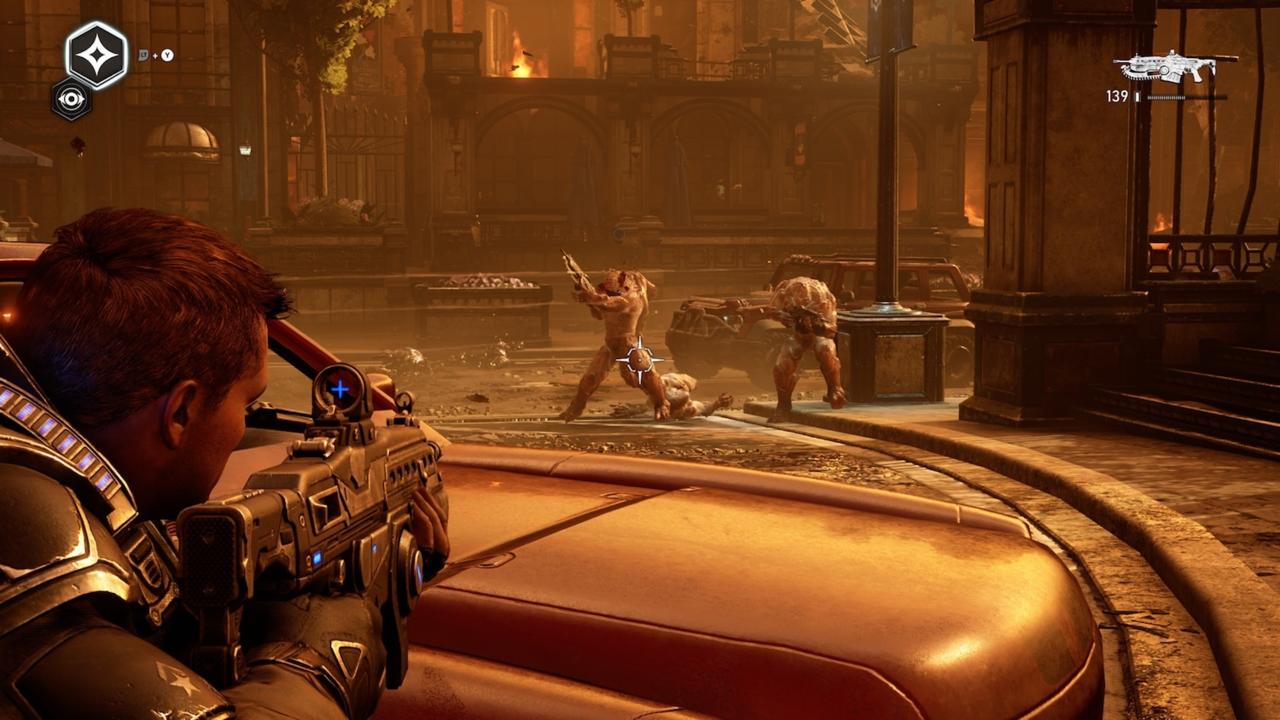
While the new elements don't stop Gears 5 from feeling true to the earlier games in the franchise, at least in its 12-hour story campaign, there's also a lot of ground that's being revisited. The Locust are back, but they're called the Swarm now. You'll spend some time trying to convince straggly bands of surviving humans to join forces with the fascist COG army to fight the Swarm, but these folks aren't called the Stranded anymore; they're Outsiders. Most of the game concerns bringing a franchise superweapon, the Hammer of Dawn, back online to use against your enemies. Gears is undoubtedly back in the same territory it covered with the trilogy that wrapped up back in 2011, and while some of the tools in this war are different, the war has mostly gone unchanged. Gears 5 is weakened somewhat by being mired in the past; there are some strong moments in its campaign, but it struggles to move forward in a way that's a satisfying continuation of the narrative.
The story picks up not long after the events of Gears of War 4, in which JD Fenix--son of series poster boy Marcus Fenix--and his pals Del and Kait discovered the Swarm threat and set out to stop it. You'll mostly just run around shooting various groups of Swarm monsters from behind cover in much the same way you always have in previous games--but Gears 5 breaks things up with a few variations on the gameplay that improve on its predecessors.
Instead of focusing on JD and his relationship with Marcus as in Gears 4, the sequel recenters on Kait, who lost her mother to the Swarm at the end of the last game. Gears 4's ending suggested that Kait has a connection to the Locust horde that Marcus helped to genocide 25 years ago, and a good portion of Gears 5 is about exploring that connection and uncovering secrets long buried by the COG government.
The first and last Acts are more traditional Gears fare, in that you're guided through a series of missions that are mostly about taking objectives, backing up other squads, and killing giant monsters. But in the middle of the game, Gears 5 changes the pace with two open segments. You hop aboard a skiff, which is essentially a dogsled with a sail on it, and zip over the terrain of a snowy valley and across a vast desert. These areas feel fundamentally different from past Gears games, allowing you to explore and look for side objectives where you can pick up small subplots of story and grab hidden collectibles and upgrades, advancing the main plot (or not) at your own pace.
The open areas don't take you too far out of the Gears norm--you won't be accosted by roaming forces or stuck in a shootout in the middle of the wilderness. Arriving at any point of interest usually sends you on a short mission where you'll explore a building or wander into an arena filled with enemies. They're like mini Gears levels that you can take or leave, usually with an ambush to tangle you up and some weapons, upgrades, or a bit of lore waiting at the end.
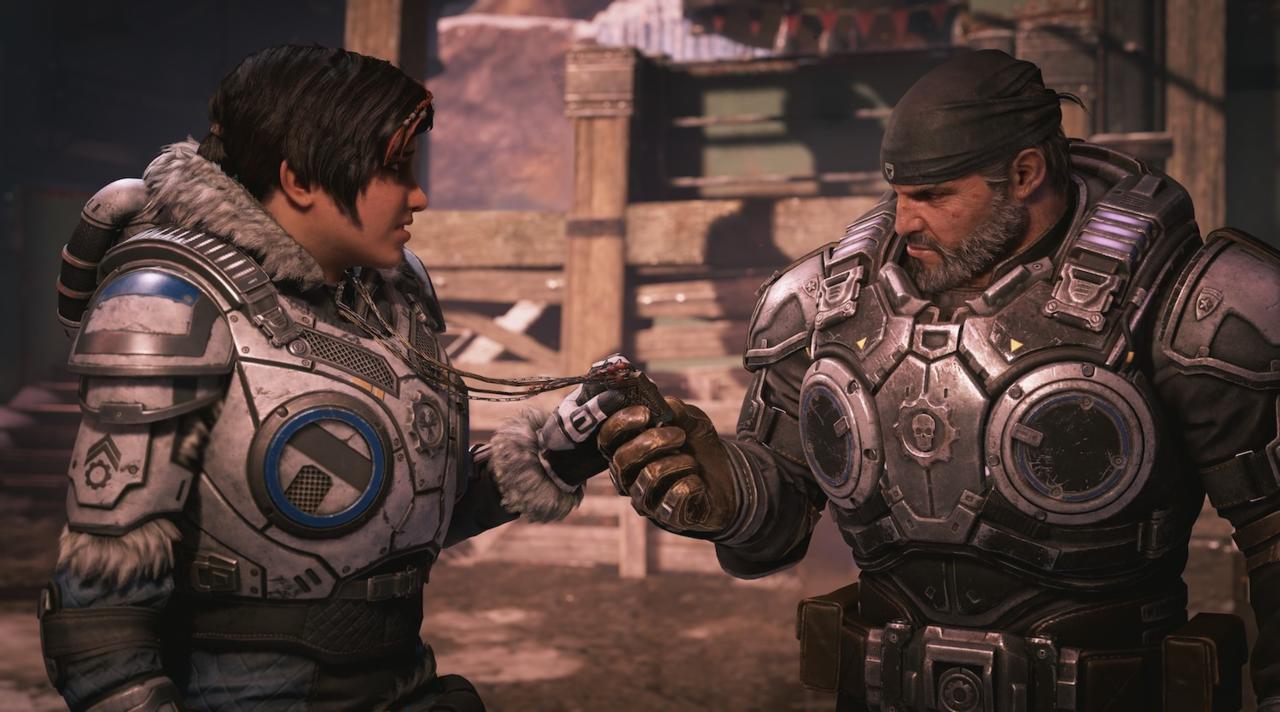
Story On A Small Scale
What's really enticing about these areas, though, are the many small moments they allow between characters. Act 2 finds Kait and Del on their own as they explore Kabar, a frozen alpine region full of old COG labs and fortifications that you'll search for Kait's answers. But the entire segment is fleshed out through a series of character-building conversations between Kait and Del as they hang around together, basically on a shooty road trip. Gears 5's writing is at its best in these character conversations, and the intimate time spent with characters in Acts 2 and 3 help you feel closer to them. Listening to Kait tell Del what she's worried she might uncover, or Kait making fun of Del for dropping tons of esoteric knowledge about things like the commercial lumber industry, bring you closer to the characters than any number of battles with AI teammates do.
Kait provides an interesting alternative viewpoint to the proceedings as Gears 5's protagonist as well. She's fundamentally an outsider--in the sense of her anti-COG upbringing, her somewhat arms-length relationship with the city-boy soldiers with whom she fights, and her apparent ties to humanity's greatest enemies. The game doesn't necessarily spend a ton of time exploring that idea, but in the conversations between Delta squad members, we get a much better sense of the distance Kait feels from her friends.
Unfortunately, the rest of Gears 5's story is uneven. Though Kait's desire to find out more about her connection to the Locust is a strong drive to push the narrative forward, Gears 5 pretty much wraps up what feels like her central drive by the middle of the game. The rest is just about Delta cruising around completing various tasks to fight off the growing Swarm threat, while the more personal stuff is left to linger. Exploring the destroyed desert facilities of the COG's old human enemies, the UIR, is a fun diversion full of a lot of pitched battles, but as far as the characters are concerned, nothing impactful happens outside of a bunch of big action set pieces. Gears 5 plays out its best story moments early, and it ends without doing much with the reveals and turning points it does create.
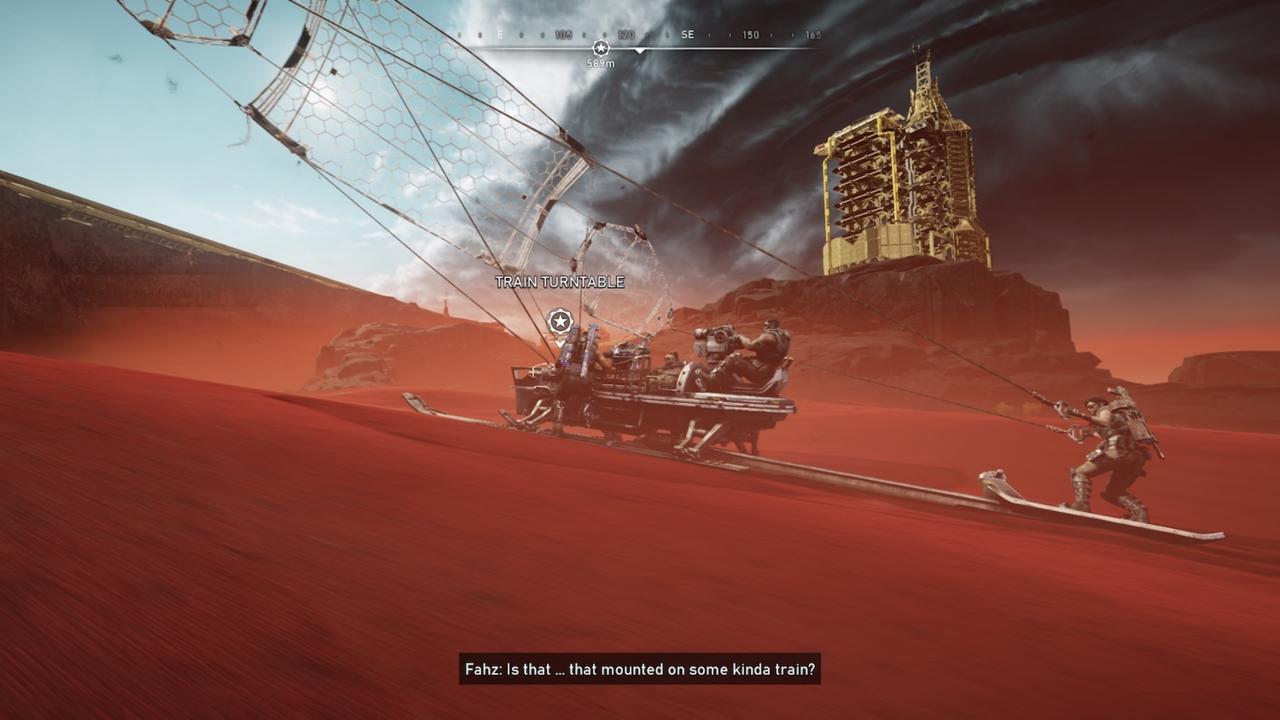
The story ultimately feels somewhat truncated and meandering, but the campaign is still fun to play. Some key changes in the structure do a lot to provide new opportunities in the old framework. Since you're exploring areas at your own pace, you'll often come across unaware Swarm soldiers searching for ammo or prepping for combat, which gives you a chance to stealthily take some out. You also have a new set of abilities for your squad to use on the battlefield thanks to Jack, the R2-D2-like robot that follows you around on missions. Jack can zap enemies to injure them, flash enemies to stun them and make them break cover, ping their locations, turn you invisible, and even take over an enemy's mind for a brief period.
Jack effectively provides Gears 5's campaign with a progression system, and coupled with the more varied gameplay and some slight squad control in the form of marking targets, he helps take Gears out of its cover-shooter comfort zone somewhat. Quickly swapping through and using Jack's abilities gives you a chance to make new decisions in combat or take advantage of different ways to play that you couldn't before, like by activating invisibility to slip through the front lines for a flanking position or using the Stim ability to strengthen yourself so you can melee to death a hulking Swarm Scion.
Jack has a skill tree that lets you improve his abilities along a few different paths, allowing you to tweak his capabilities to better fit your playstyle. He's also the major reason to complete side missions and search all those nooks, crannies, dead ends, and side areas that litter Gears 5. While those side activities sometimes give a bit of a better understanding of the story or the world, the big reward is almost always an item that helps you improve Jack's abilities.
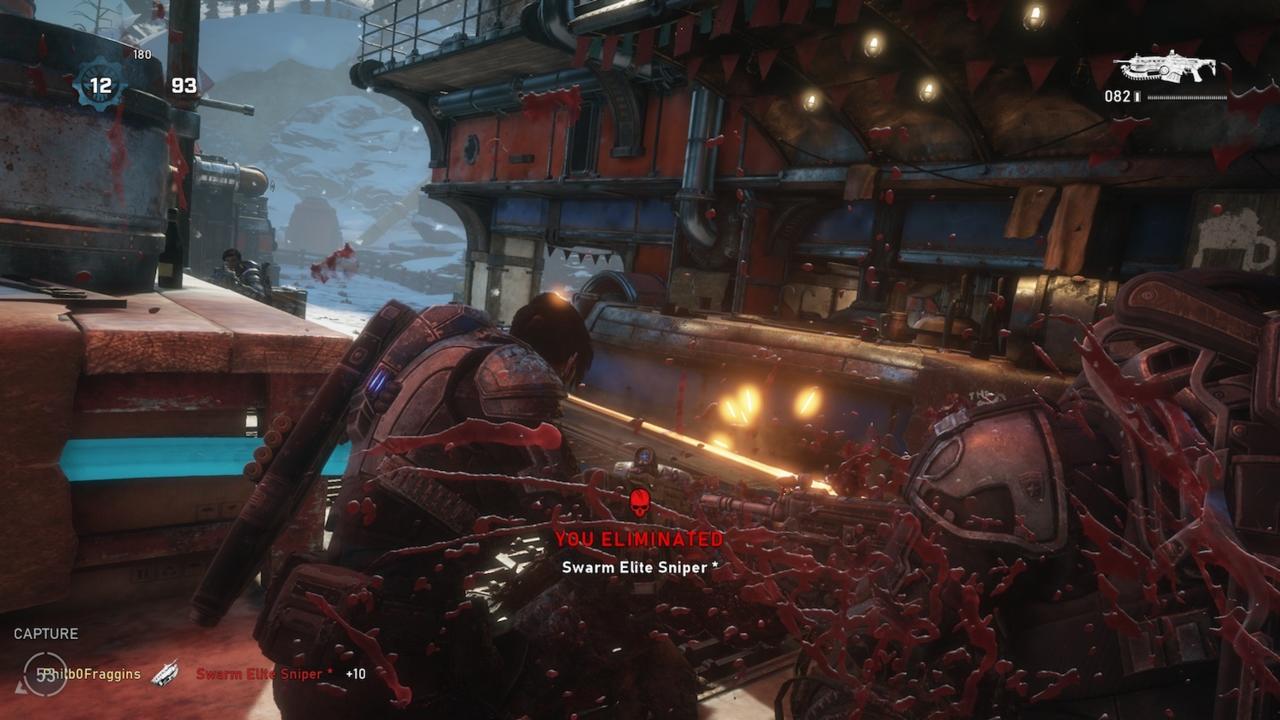
Multiplayer, But More
As with the campaign, The Coalition doesn't reinvent the series' standard multiplayer in Gears 5--but much of it sees improvements aimed at adding customization and support for varied playstyles. The franchise's usual competitive multiplayer is back, where two teams of five players face off, with options segmented into more casual Quickplay and more hardcore Ranked playlists.
Gears 5 multiplayer doesn't fix what isn't broken--it's striking how much Gears 5's competitive modes feel like, say, Gears of War 3, and are fun in the same ways. You'll still spend a lot of time in cover, dance around other players with shotguns, and sprint for the power weapons at the start of each match. Maps are symmetrical with teams spawning on either side, with tactically superior high ground at one end and lower, tighter areas at the other. Since it isn't changing the core feel of the gameplay, The Coalition has expanded on it by offering more options for multiplayer, so you can find the modes you like, and metagame progression systems, to make your time feel more meaningful.
Quickplay includes a bunch of different game types that fit the Gears framework, while pushing you to play a little differently in every match. Its modes include classics like King of the Hill, as well as Gears of War 4's weapon-based Arms Race (a literal race to get kills with a host of different guns) and Dodgeball, in which you can't respawn unless a teammate kills a member of the opposing squad. The Ranked mode, on the other hand, plays things straighter with simpler modes like Team Deathmatch.
It's very easy to see the influence live service games have on Gears 5, with an overall level-up system for your multiplayer persona, the ability to unlock more guns for your starting loadouts, and lots of customization options. They're all of a type similar to what you'd see in something like Fortnite--nothing that would draw you into multiplayer on its own, but plenty to give you new unlocks to chase and to help multiplayer feel like it has more depth than just a series of matches to play. Those progression systems are handy for giving Gears 5 multiplayer some depth, providing you stuff to focus on in between matches, but they're also ancillary enough that they can be safely ignored if you don't care about unlocking new background banners or weapon skins. It should be noted also that, like live service games, Gears 5 also includes customization items you can grab by spending money on premium currency.
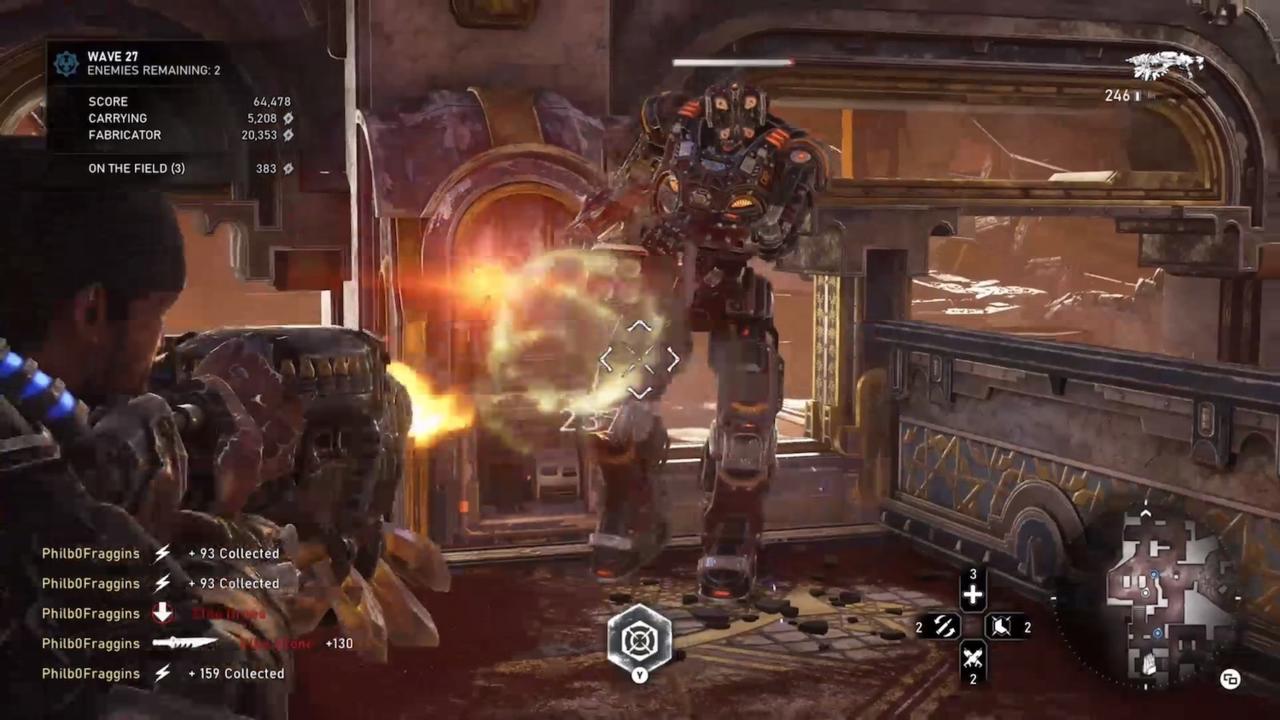
Specializing In Co-Op
The bigger refinements come in Gears 5's co-op modes. Here, Gears 5 furthers an emphasis on teamwork and specialization, and again, the live service influence is apparent.
Horde mode returns, in which five players team up to take on 50 waves of enemies while building fortifications and buying new weapons in between each round. It sees some tweaks to the rules, with elements like shared resources, the ability to spend those resources on character perks to make yourself stronger, and greater character specialization that gives you more of a particular job as you work together to survive. New to the cooperative scene is Escape, in which you race through a Swarm Hive as a squad of three, trying to outrun deadly gas as you find your way out and kill enemies along the way. Escape differs from the other modes in that you have limited weapons and ammo, forcing you to search for more resources as you go and to work together to stay alive, especially on higher difficulties.
Both modes add more ways to engage with Gears 5, and they share their own live service-style progression systems that let you level up characters, customize their capabilities and loadouts, and generally make them more your own. The characters you choose in both Horde and Escape each have different roles and special abilities, including an Ultimate ability that charges up over time. You can even play as Jack the robot in an almost purely support role, providing something for players who prefer backing up teammates over scoring headshots. On the surface, Horde and Escape play pretty similarly to Gears' other modes, and the characters aren't drastically different from one another in most cases. But the ability to unlock new perks and abilities gives the sense that your characters are advancing as your skills improve, and the more time you put in, the more specialized and different each character becomes.
Gears 5's additions make the whole package feel denser and more involved--even if it still plays very similarly to Gears games in the past. To some degree, there's almost too much progression to deal with; it's a lot to learn and keep in mind, and it takes a while to build up good-enough perks that your characters really start to become different from one another.

But what makes Gears 5 work well is that those additions feel like a useful evolution of the core Gears concept, even if a lot of these ideas--like an involved character progression system or a Battle Pass-like rewards path--are also becoming commonplace among shooters. 13 years after the franchise's first release, The Coalition's additions to Gears 5 are all things that seem right at home with the elements that give the series its identity. The upshot is, there are lots of options, and while you might not play them all, there's probably something that fits the kind of player you are.
Gears 5 is very much a return of those best elements of Gears of War, but with a focus on making the game feel somewhat more adaptive to your particular ways of playing. Whether you want campaign or co-op, Competitive or Quickplay, there's an option for you in Gears 5, and plenty of stuff to reward you for time spent and skill gained. Gears 5 might suffer from some of the same storytelling missteps as its predecessors, and it might not venture far out of the past, but the new ideas it brings to the series are all good reasons for fans to return.



















